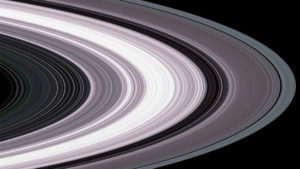Dec 15 2017
Saturn’s Rings Are Younger Than Previously Thought
 The gorgeous rings of Saturn are one of the most dramatic features of our solar system, and certainly a favorite of any backyard astronomer. Are they, however, a fixture that have been present for the majority of the life of our solar system, or are they a recent addition?
The gorgeous rings of Saturn are one of the most dramatic features of our solar system, and certainly a favorite of any backyard astronomer. Are they, however, a fixture that have been present for the majority of the life of our solar system, or are they a recent addition?
Of course we have no observations from millions or billions of years ago, so we can only infer their probable age. Up until recently astronomers believed they were probably ancient because the large collisions that likely produced them would have been far more likely in the early crowded solar system. However – recent evidence from Cassini has changed that conclusion.
The Cassini probe made detailed observations of Saturn and its rings for years, until it plummeted into the planet this September. Scientists are still analyzing all the data it sent back home. Two lines of evidence suggest that the rings of Saturn are far younger than previously suspected.
The first new finding deals with the thickness of the rings, especially the main B ring. Astronomers estimated the amount of mass in the rings, and concluded that they were collectively greater than that of Saturn’s moon, Mimas. This further suggests that a massive collision produced them, leading to the ancient ring hypothesis. Cassini observations have revised our estimate of the rings’ mass, however:
Iess leads Cassini’s radio experiment team, which used tiny Doppler shifts in the spacecraft’s radio signal to determine the mass of objects it orbited. When Cassini began threading the gap between Saturn and its rings during its last passes, the team could pick out the gravitational pull of the rings—and hence their mass. “The central value is consistently 0.4 Mimas’s mass,” Iess said.
So there is less mass in the rings than we thought, which makes a more recent origin more plausible. This seems like a pretty thin line of evidence, but the next one is more significant. Cassini also made observations that revised our estimates of the rate of “micrometeorite flux” – this is the rate at which dark sooty micrometeorites fall into Saturn from the outer solar system. This dark dust would darken the icy rings of Saturn. We could therefore use a measurement of how dark and sooty the rings are to estimate their age. However, we also need to know the rate at which that is occurring – the flux.
Painstaking measurements by Cassini over 12 years has given us a much more accurate measurement, which is 10 times the flux that was previously estimated. That, by extensive, revises down the estimated age of the rings based on their sootiness. This is a much stronger line of evidence and comes pretty close to a direct measure of their age.
The new age estimate for the rings is only 150-300 million years old. That is much younger than previously thought.
That means for most of the life of the solar system Saturn did not have its current ring system. Perhaps we are just lucky to be living in a time when we have such a rare and lovely spectacle.
A related question is, how long will the rings last. This has not yet been answered, but Cassini data may yet help us with that question also. The rings do appear to be raining into Saturn from the near edge. Material from the rings are also bleeding out from the outer edge. But there is currently a wide range of estimates of how long such rings survive, and no clear consensus. It’s possible they will last less than a billion years, or shorter.
That could mean that ring systems around the major gas giants come and go over the several billion year history of our solar system. All the gas giants have some rings, but for Jupiter, Neptune and Uranus they are thin. Are these thin rings remnants, or were they formed thin? A billion years ago did Jupiter have a massive ring system while Saturn was relatively bear?
We may never know the answer to that question, but it is also possible we can infer more about the past from the remnants of today. And that is the deeper lesson here. We can know about the past scientifically through reasonable inference from the information we can gather today.






